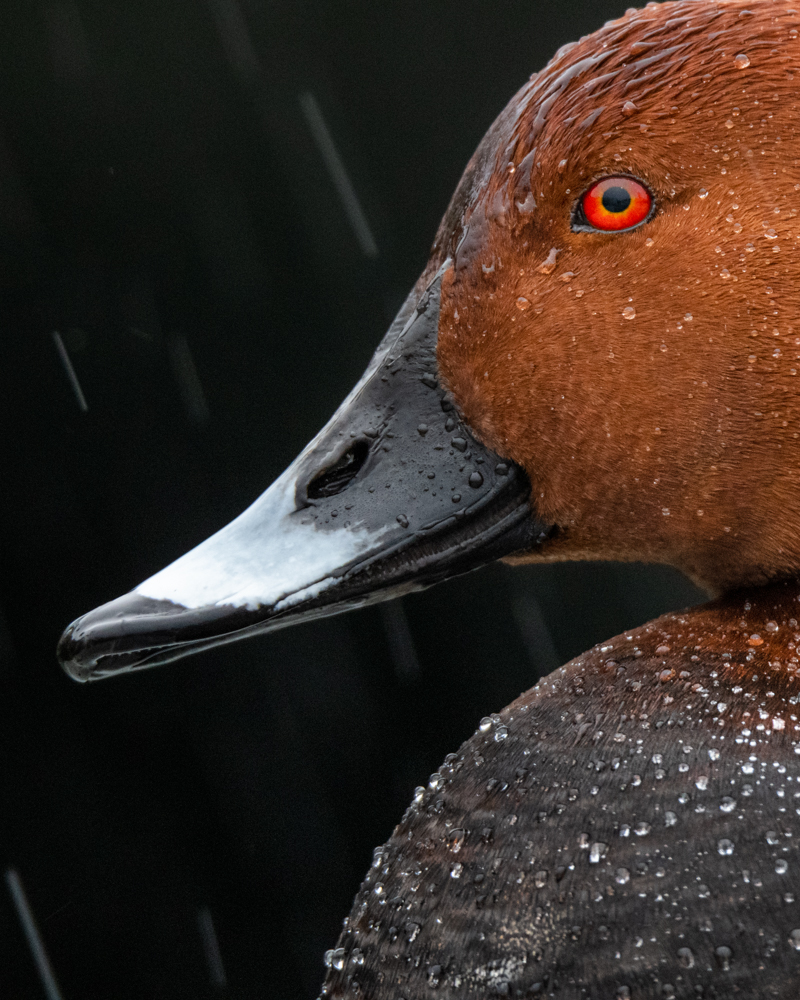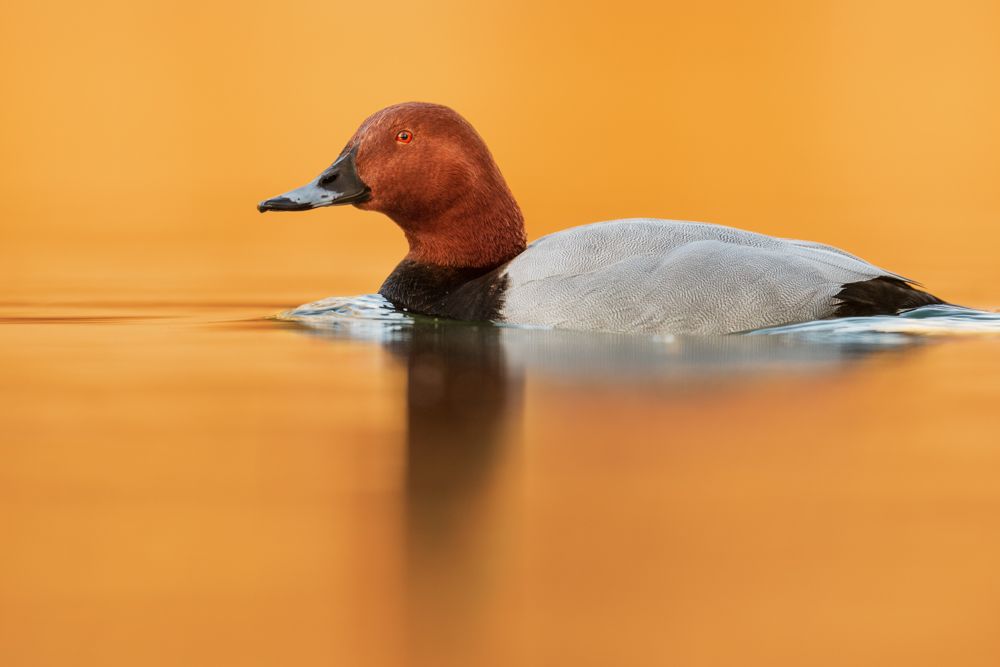Pochard (Aythya ferina)
Profile
Scientific name: Aythya ferina
Class: Birds
Order: Anseriformes
Family: Anatidae
Length: 42-49cm
Wingspan: 72-82cm
Weight: 700-1100g
Distribution: Palaearctic
Breeding population CH: 6-9 pairs
Habitat: Lakes, slow-flowing waters
Migration behaviour: Short-distance migrant
Appearance & Identification
The male pochard can be identified by the reddish-brown head or the grey patterned body. The fine pattern can only be seen at short distances. At long distances, the body appears uniformly grey. The chest and tail are black. The beak is mainly black but has a variable proportion of grey. The nail (tip of the beak) is also black. The eye, like the eye of the Red-crested Pochard, is coloured red.
In summer, the male pochards moult into a plain dress. This is similar to the breeding plumage. The black chest is more diffuse and slightly brownish. The back and sides are also slightly brownish.
The female of the pochard is in general a lot browner. But overall, it shows the same characteristics as the male. The female also has a grey patterned body. However, this is slightly darker and slightly brownish. Chest and tail are more intensely brown and unpatterned. The head is also brown, especially at the base of the beak some individuals show a white spot. In addition, many females have a short, fine line behind the eyes.
Risk of confusion
Although pochards are rather inconspicuously coloured, the identification of this duck does not pose any problems in most cases. Both males and females show unique characteristics in all plumages.
Habitat
The pochard breeds mainly on nutrient-rich lakes and watercourses with dense underwater vegetation.
In winter, however, the pochard can be found on all larger waters in Switzerland. Some pochards are often hidden among the large flocks of tufted ducks that spend the winter in the harbour.
Distribution in Switzerland
As a breeding bird, the pochard is a regular but rather rare species in Switzerland. The population is estimated at 6 to 9 breeding pairs. This number varies from year to year and a clear trend cannot be identified. In winter, however, the pochard is very common. According to the monitoring of wintering water birds of the Vogelwarte, the winter population counts about 70'000 individuals. After the pochard populations increased sharply at the beginning of the 1960s, the increase flattened out from the 1980s onwards and the population is now declining slightly.
With the introduction of the zebra mussel in the 1960’s, mussel-eating species such as the pochard and tufted duck have greatly increased. Due to climate change, however, many water birds now have to migrate less far south to find open waters. As a result, fewer and fewer pochards spend the winter in Switzerland.
Diet
The pochard feeds mainly on animal food such as mussels, crabs and insect larvae. In Switzerland, pochards benefit from the zebra mussel. The zebra mussel was introduced over the Rhine in the 1960s and has spread rapidly since then. Since then, the pochard population has increased considerably.
Breeding behaviour
Typical for all duck species, the female alone takes care of the brood. The nest site is well hidden in the lush shore vegetation. The clutch size varies between 6 and 11 eggs. The female incubates them for about 28 days. The hatched young are nest escapees, they leave the nest after a short period of time. Although the young still follow their mother, they have to find food themselves. After 50 to 55 days the young are able to fly.
Other species often lay their eggs of in the nests of pochards. The red-crested pochard, for example, likes to lay eggs in the nests of the pochard.
In addition, pochards are known to hybridise with tufted ducks, moorhens and red-crested pochards. The appearance of the resulting hybrids is very variable and the hybrid is accordingly quite difficult to determine.
Migration behaviour
Apart from the few breeding birds, thousands of pochards migrate to Swiss waters in winter. On their migration, pochards often form larger groups with tufted ducks. The two species also often live together in the wintering area.
The males in particular often return to Switzerland in summer. Particularly at Lake Constance, the males gather in larger groups to moult together in their simple dress.
Photographing the pochard
Pochards can be observed and photographed in winter at practically all larger water bodies. However, they are always quite shy and difficult to photograph. The Klingnauer Stausee or various harbours on Lake Constance, for example, are quite suitable for photography.
Other species
Resources
The population figures, length, weight and wingspan correspond to the data of the Vogelwarte Sempach
Information on behaviour, distribution etc. is based on my own observations and was supplemented with information from the following sources:
The Birds of Switzerland (2007) Lionel Maumary et al.
Swiss Breeding Bird Atlas 2013-2016
The Cosmos Bird Guide (2017) Lars Svensson et al.
































